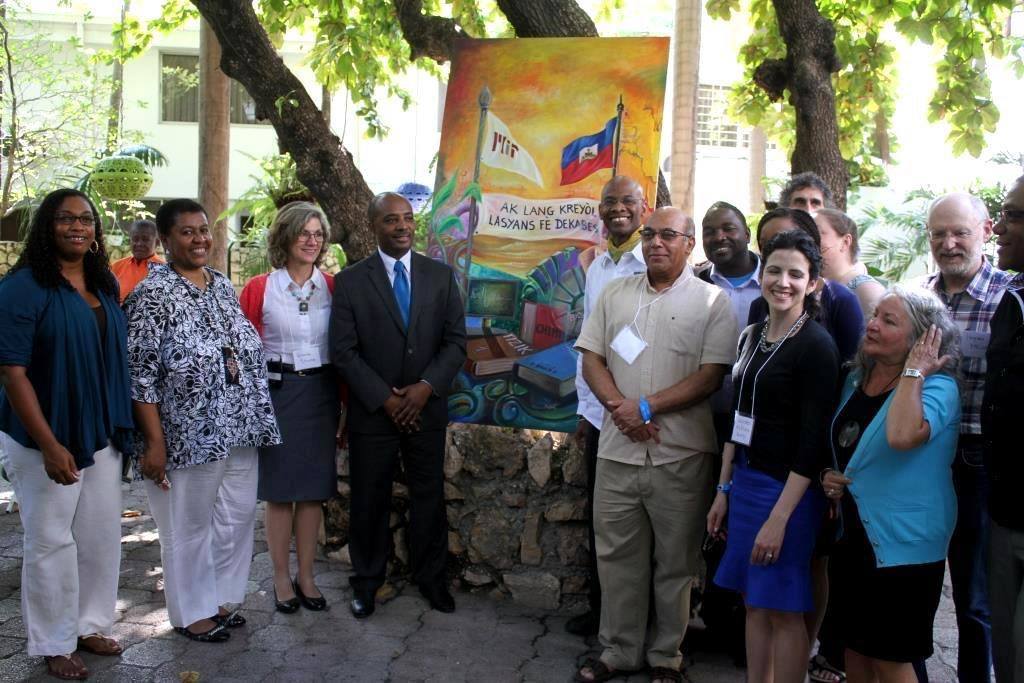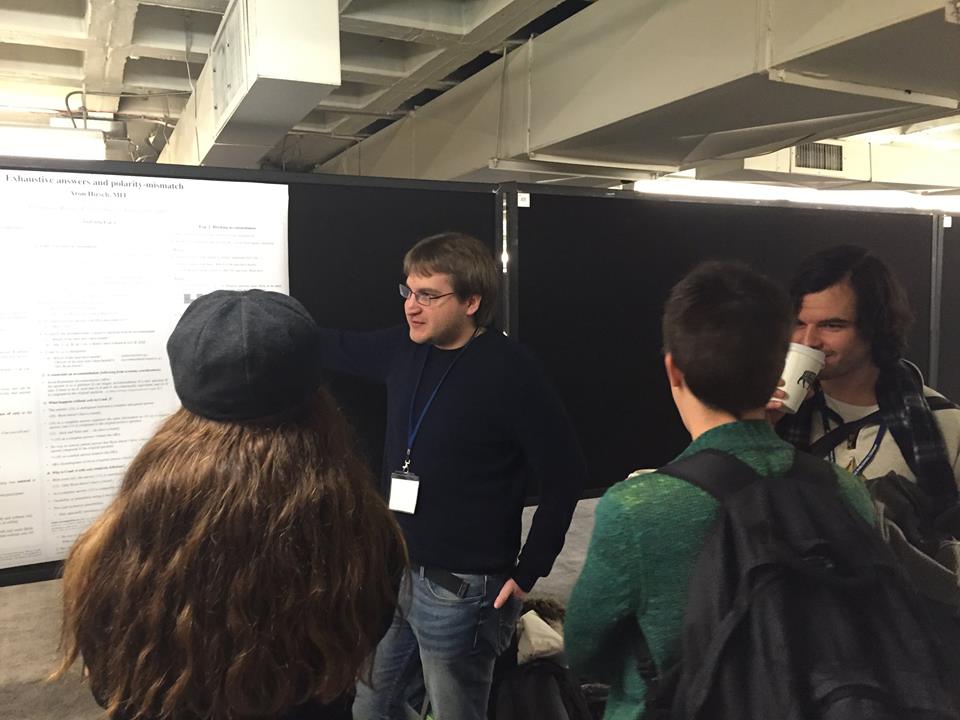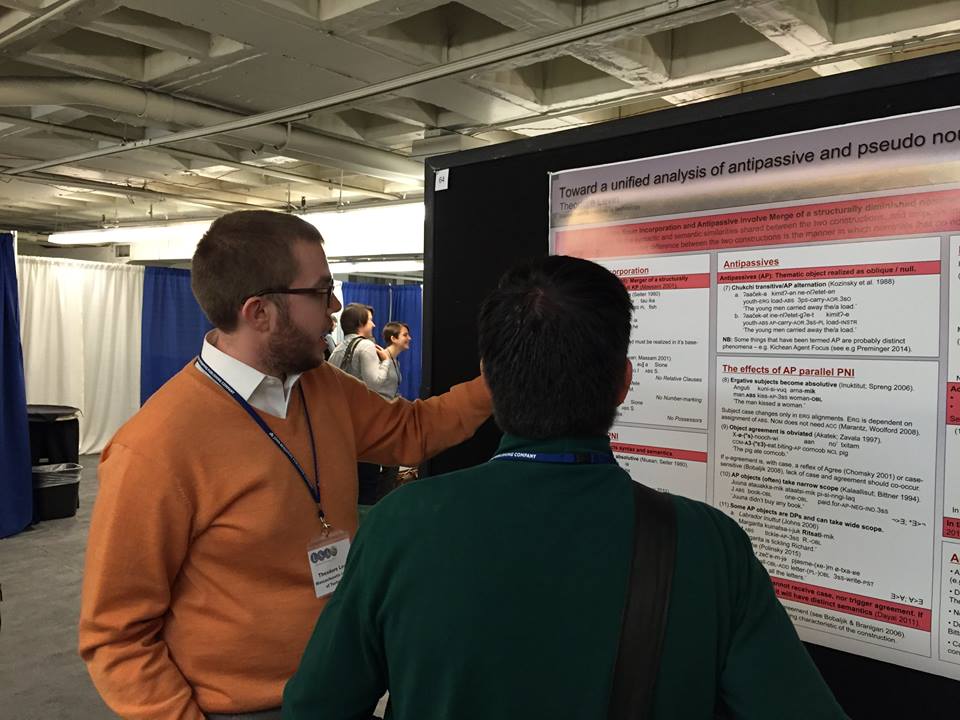24.954: Pragmatics in Linguistic Theory
Instructors: Danny Fox, Irene Heim
Time: MW 10-11:30
Room: 56-162
24.956: Topics in Syntax
Syntactic structure: outstanding puzzles of cyclicity, overtness, and linearization
Instructors: Danny Fox and David Pesetsky
Tuesdays 10-1, 32D-461
According to a familiar and relatively minimal view of syntax, all structures are constructed from primitive elements by recursive external or internal Merge of two preexisting units. This view derives a very strong version of the strict cycle, the Extension Condition — with well-known salutory consequences both empirical and conceptual. On the face of it, however, this simple view is incompatible with analyses of a wide range of phenomena that posit, or might have to posit countercyclic Merge involving positions other than the root. For example:
- Late Merge: Following Lebeaux (1988), Chomsky (1995), it has been argued that Merge can add elements to a phrase that has been moved, so that the added elements are present in the higher, but not the lower position. This operation appears to be countercyclic by its very nature, but is supported not only by the binding interactions discovered by Lebeaux, but also by Fox & Nissenbaum’s (2003) analysis of modifier extraposition; Takahashi & Hulsey’s (2009) explanation for anti-reconstruction effects for A-movement; Stanton’s (2014) explanation for asymmetries in English P-stranding; Stepanov’s (2001, 2007) explanation for CED effects; and Johnson’s (2010) tangled-tree alternative to Fox’s trace conversation — among other proposals.
- Covert movement: The standard view of covert movement (Chomsky 1975; May 1977) explains its covertness as a consequence of a second syntactic cycle after Spell-out — a claim supported by Huang’s claim (1982) that covert movement creates configurations that can block later covert, but not overt, movement.
- Tucking in: Following Richards (1997; 2001), it has been argued that the formation of multiple specifier constructions is crucially countercyclic, with the outermost specifier merged first. This claim permits a simple locality explanation of the relative ordering of internally merged specifiers in many languages — but at the cost of a crucially countercyclic derivation.
- Multidominant sharing: Since McCawley (1982), a number of researchers have developed detailed proposals for the analysis of constructions in which elements appear to occupy multiple positions that are not in a c-command relation — and therefore cannot be easily explained as standard instances of movement. These include the wh-coordination, bulk and non-bulk sharing structures studied by Gračanin-Yuksek and Citko (independently and in co-authored work) and by De Vries in many papers. They also include proposals concerning Right Node Raising by Wilder, Sabbagh, and many of the authors just cited — plus interactions with island phenomena explored by Bachrach & Katzir, O’Brien, and others.
In this class, we will spend time exploring each of these domains for which the simple “first-year syntax” view of Merge looks inadequate (at first glance, and maybe second glance too). So at the very least, we promise that you will leave with you head full of exciting problems in empirical domains that may be new to you — and ideas about possible directions to pursue solutions.
At the same time, we will be pursuing a hunch of our own, that the solution to some aspects of these problems is closely connected to certain puzzles of word order: in particular, what determines the relative order of complements and specifiers, and what determines whether movement is to the left or right. For this reason, we will probably spend at least a class near the end of the semester discussing the Final-over-Final-Constraint, and various proposals for deriving it.
But it should come as no surprise that our main focus throughout the semester will syntactic structure itself, and the question of what operation produces it.
Course requirements:
- weekly readings
- active class participation including some in-class problem solving
- two squibs: the first reviewing some paper on a topic related to the class, the second exploring (but not necessarily solving!) a puzzle of your own related to the class
First class:
Danny will talk about arguments for Late Merge, his own recent work on how deep it can apply (contradicting some recent claims by Sauerland and Stanton). No reading.
24.965: Morphology
Instructors: Adam Albright, David Pesetsky, and Martin Walkow
Time: Mondays, 2–5 (note: first class is 2/9)
Location: 66-156 (note: not the room you expect!)
Topics in the structure of words and their components. The leading question underlying the course will be: is there a distinct morphological grammar, or can morphological phenomena all be understood as arising from the interaction of syntax and phonology?
Particular questions to be discussed in light of this leading question include:
What is the evidence for structure below the level of the word?
What (if anything) distinguishes word structure from sentence structure?
What principles account for the order of morphemes?
How does morphological structure influence the phonological shape of complex words?
Why does morphology sometimes fail to express syntactic/semantic differences (one affix, two functions), and how do multiple morphemes compete to express the same meaning?
Course website: http://stellar.mit.edu/S/course/24/sp15/24.965 (currently empty; to be stocked with readings soon)
Course requirements:
- weekly readings
- active class participation including some in-class problem solving
- discovery of a data-rich problem to explore for term paper and class presentations of your work on that problem
- written term paper
Syllabus: Will be available sometime in the next 4-5 days, but for a glimpse at an ancestor of this class, look at the Stellar pages from 2012, including that year’s syllabus. Some of this year’s topics will differ, but the overall gist will be similar.
24.967: Topics in Experimental Phonology
Instructors: Adam Albright (albright@mit.edu), Edward Flemming (flemming@mit.edu)
Time: Tuesdays 2-5
Room: 32-D461
In the past decade, the field of phonology has increasingly looked to experimental results to confirm and extend its understanding of phonological patterns. In this course, we will examine some of the issues involved in deriving experimentally testable predictions from a theory, designing and running an experiment, and interpreting the results.
The class has several goals:
- Consider the relation between phonological theory, empirical predictions, and experimental results
- Gain practical knowledge in designing and carrying out experiments in the lab and on-line, and performing data analysis using R
- Gain familiarity with some commonly used experimental paradigms, comparing what they can tell us about the linguistic system
The class will be organized around a set of phonological topics that have benefited from experimental investigation. These topics will serve to illustrate a variety of experimental and statistical techniques:
- Sonority sequencing preferences
- Generalization from the lexicon
- Perceptual similarity
- Phonetic underspecification
Requirements:
- Readings and class participation
- Regular assignments (modest and practical in nature)
- Final project: designing (and perhaps piloting) an experiment
24.979: Topics in Semantics
Instructors: Kai von Fintel, Irene Heim, Sabine Iatridou
Fridays 12–3, Room 32-D461
This semester’s semantics seminar will consist of three “mini-seminars”:
Conditionals without “if” (2/6, 2/13, 2/20, 2/27)
The semantics of tense (3/6, 3/13, 3/20, 4/3, 4/10)
The semantics of surprise (4/17, 4/24, 5/1, 5/8)
Course website: http://stellar.mit.edu/S/course/24/sp15/24.979/
Students who are taking the seminar for credit are expected to attend all sessions and to submit a term paper on a topic related to one of the topics of the seminar. Auditors are welcome to attend any of the three parts of the seminar.
24.S96: Computational Phylogenetics
Instructors: Bob Berwick & Michel DeGraff
Time: Thursdays, 2–5
Location: Room 32D–461
In this course, we’ll endeavor to make the inscrutable scrutable. Computational
phylogenetic methods have been gaining wide currency among, and seem convincing to,
linguists of various theoretical stripes. Yet, these methods and their results are often not
fully understood. In this seminar we will explore the scope and limitations of
computational phylogenetics methods in historical linguistics, especially in studies on
Creole formation, with an eye toward the improvement of such methods. Creole languages
have traditionally been excluded from the scope of the Comparative Method, generally
because it has been thought that methods that reconstruct phylogenetic trees of related
languages are not applicable in the case of Creoles (Taylor 1956, Thomason & Kaufman
1998, Ringe et al 2002, Nakhleh et al 2005b, Labov 2007, etc.). Recent studies continue to
claim that Creoles lie outside well-established language families, constituting an
exceptional typology as the least complex human languages (Parkvall 2008, McWhorter
2011). In a related vein, Bakker et al 2011 and Daval-Markussen & Baker 2012 enlist
phylogenetic tools (i.e., Splits Tree from Huson & Bryant 2006; cf. Dunn et al 2008) to
argue that “Creoles are typologically distinct from non-Creoles.” In this seminar we will
start with some general background on Creole studies and computational phylogenetics,
and then we’ll evaluate the applications of computational phylogenetics to Creole studies.
Much of the seminar will involve hands-on active-learning activities as we delve first-hand
into the nuts and bolts of computational phylogenetics and applications thereof to Creole
data. One overall objective is to better understand the scope and limitations of the
computational phylogenetics methods and how to improve on their applications in
historical linguistics, especially in Creole studies. Given historical linguists’ increasing use
of both computational phylogenetics and language-acquisition findings, it is important that
such methods be reviewed with great care, as we’ll do in the seminar, before they can be
constructively and reliably applied in the analysis of language-creation and language change
phenomena.
For more information, in particular concerning the course requirements and schedule, please visit the course website: http://stellar.mit.edu/S/course/24/sp15/24.S96/


